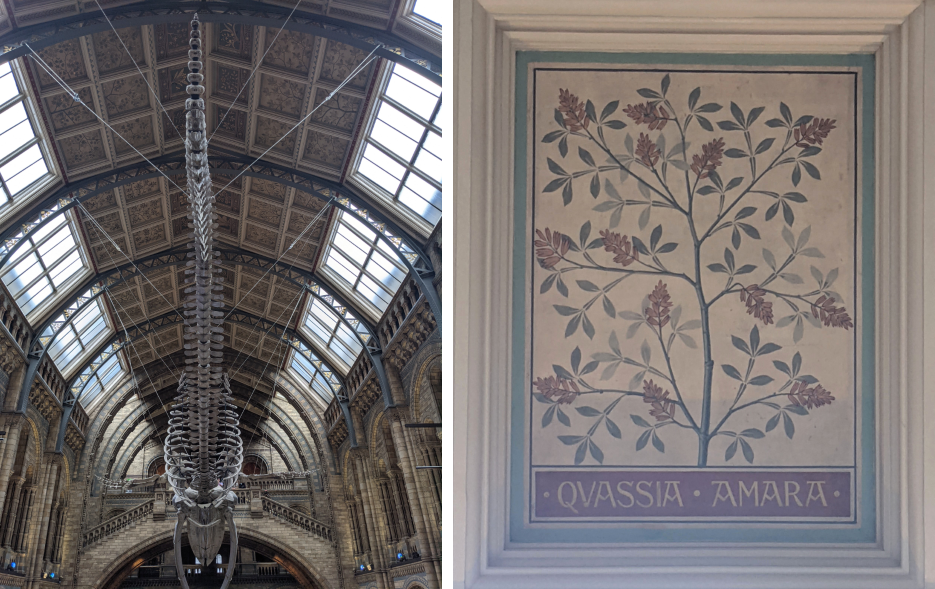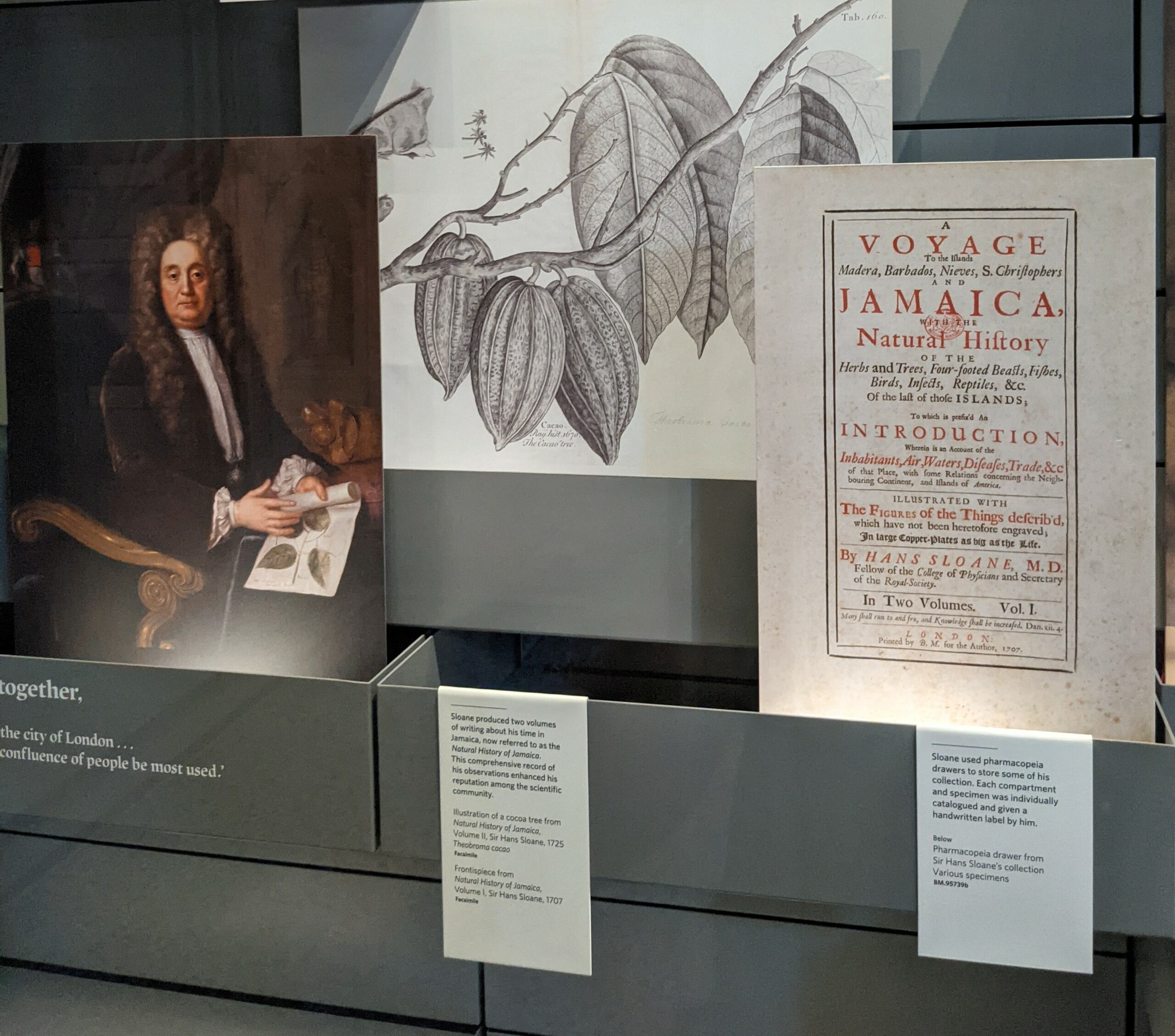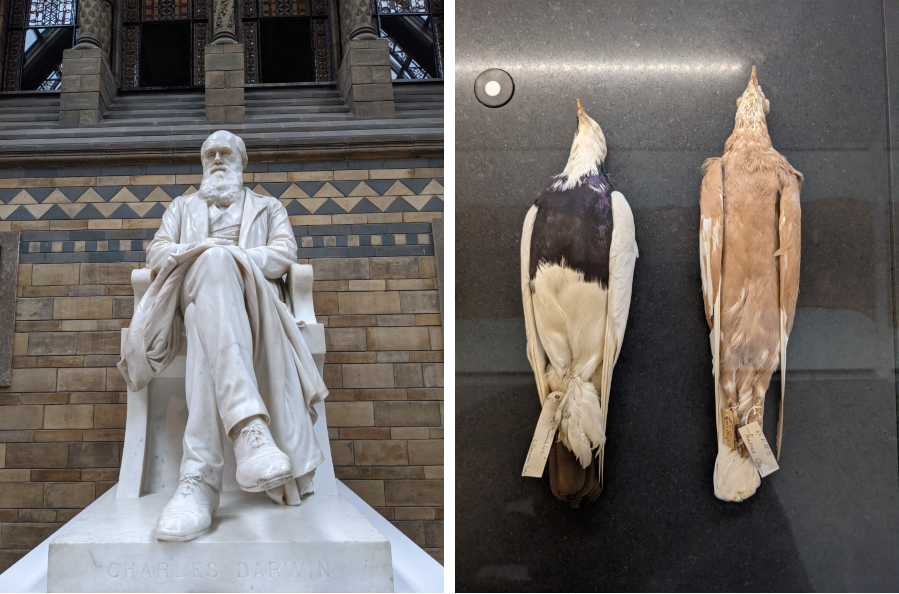THURSDAY, 6 JANUARY 2022
When you first enter the Natural History Museum (NHM) in London through the Hintze Hall and look to the ceiling, you see the museum's "Gilded Canopy". It consists of 162 hand-decorated panels, depicting ornamental, commercial and medicinal plants from across the world.One of these panels shows Quassia amara or bitter-ash, which became well-known for suppressing vomit and fever due to Linnaeus' publications. However, Linnaeus did not discover this plant himself, and in fact named it after its true discoverer, an enslaved Ghanian named Kwasimukamba or Graman Quassi.

Kwasimukamba worked on sugar plantations in Dutch-controlled Suriname, and was skilled in obeah, medical-spiritual knowledge. He became a healer and botanist, treating slaves and Europeans with his medicines. He eventually sold his Quassia-based formula for medicinal tea to a student of Linnaeus. Today, Quassia is used in modern drugs for intestinal problems and malaria, and as a flavouring. Such applications are only possible due to the work of Kwasimukamba, but his name is scarcely mentioned in the NHM, making him just one of the countless enslaved peoples whose contributions to science have been overlooked.
A History of Natural History Museums
The original intent of natural history museums was to showcase the collections of wealthy individuals, gathered from distant lands and displayed in a show of opulence and status. Invariably, these individuals acquired their wealth through slave labour and colonial exploitation, and it is not coincidental that specimens from European colonies are well represented in such collections.
One such collection is that of Hans Sloane. Sloane was a botanist, and amassed 334 volumes of plants from around the world through gifts and exchanges. Upon his death, he instructed that his collection be stored in a free public museum, eventually becoming the foundation for the NHM. In this light, Sloane's actions seem almost egalitarian, but it cannot be overlooked that his botanising was reliant on Jamaican slavery.
Sloane was a physician on Jamaican slave plantations, where he recorded plant specimens that enslaved Ghanian men and women collected. He regarded the enslaved African population as a link to otherwise-lost knowledge of the indigenous Taino people, and sought their help in locating plants. However, he disregarded their medical traditions and interpretations, believing they required wider knowledge to use such plants effectively. Though Sloane's views on slavery are unclear, given his employment on a plantation and subsequent marriage to a sugar heiress, his collection was certainly funded and facilitated by slavery. Today, his specimens are still on display at the NHM, but rarely with mention to how he gathered his extensive collection.

Museums and their collections are thus direct products of colonial exploitation and slavery, and divorcing them from this context tells an incomplete story. Any effort to decolonise science must thus acknowledge the labour and knowledge of countless colonised people who were denied recognition in the scientific legacy they helped create.
Colonialism In Museums Today
A 2018 ethnographic study showed that the sanitisation of colonialism in science history is obvious to people of colour that visit natural history museums, making them feel excluded from science communication. This exclusion is often centred around perceptions of cultural imperialism and powerlessness, where the culture and practices of the socially dominant appear universal, yet there are no avenues for the excluded to change the terms of their participation. This is helped by the lens of "hard science", which strips specimens and exhibits of their context. The limitations of "hard science" means that certain stories are left untold, and audiences, especially marginalised audiences, are able to see what is left out. Colonialism in natural history museums is thus not just a historical anecdote, but a driving factor in structural inequalities in science. The exclusion felt by marginalised people draws a divide between those engaged with science communication and those not in the conversation.
Recently, there have been more efforts to acknowledge gaps in colonial narratives presented by natural history museums. In 2018 during Black History Month in the United Kingdom, curator Miranda Lowe led a tour highlighting stories of indigenous and African people in the NHM. This is an important step in filling the gaps in museums, but it has its limits. Having this tour only during Black History Month runs the risk of it seeming tokenistic; in the words of one participant from the aforementioned study, "we're not invited the rest of the year!" For museums to bridge the gap to marginalised audiences, they need to introduce narratives involving those audiences into the museum exhibits, rather than just additional footnotes on existing exhibits.
Going Forward
How should natural history museums move towards decolonising their halls?
Drawing on the framework set by Laenui, decolonisation consists of five phases: rediscovery and recovery, mourning, dreaming, commitment and action. Colonised peoples rediscover lost history and identity, followed by mourning for past and present assaults on colonised peoples' cultures. In dreaming, they invoke indigenous worldviews and knowledge to imagine alternative possibilities. During commitment, different voices of dreaming coalesce into a clear statement of direction, culminating in action, where dreams and commitments become strategies for social transformation. Thus, to begin the process of decolonisation, we must start at rediscovery and recovery of African and indigenous history in natural history museums.
Often, this is difficult or almost impossible, because many colonised people were recorded as statistics rather than individuals. However, some have survived in the annals of history, whose stories we can share.
At the end of Hintze Hall sits the looming figure of Charles Darwin, indisputably history's most famous naturalist. Darwin's collections of birds and insects are still kept at the NHM, but less well known is the freed slave that taught him taxidermy. John Edmonstone learnt how to skin and stuff creatures from the naturalist Charles Waterton during trips to Guyana. After Edmonstone gained his freedom in 1817, he taught taxidermy at the University of Edinburgh. It was there, in 1826, where the skilled taxidermist taught a young Darwin how to stuff all kinds of birds. Darwin later used these skills on his voyage upon the HMS Beagle, creating finch specimens that were crucial in supporting his theory of evolution through natural selection. The foundation of modern biology was thus reliant on the teachings of a freed slave, whose contributions were only acknowledged as recently as 2009.

Edmonstone's story is just one of many that have been overlooked by natural history museums, and by telling stories such as his, we start acknowledging the role of colonised people in museums, beginning the process of decolonisation. In 2019, Grant Museum opened Displays of Power, an exhibit presenting the museum's collection with information about their colonialist origins. Such exhibits bring the role of colonialism in collections to the forefront, recognizing that such collections are inextricably part of the colonial contexts that produced them.
This clear and demonstrable change is easier in smaller museums such as the Grant Museum, but for the NHM in London, such exhibits could take years or even decades. Miranda Lowe does not believe the museum can ever be fully decolonised. Yet, she writes, "Museums, originally established as colonial tools, are well-situated to do the work of public acknowledgment because their collections ... relate directly to that colonial history". Natural history museums owe much to colonised people, and acknowledgement of their efforts is just the first step in repaying this debt.
Daniel Lim is a first-year undergraduate at St. Catharine’s College studying Natural Sciences (Biology). Photographs taken by Katie O' Flaherty
